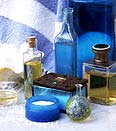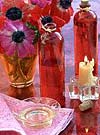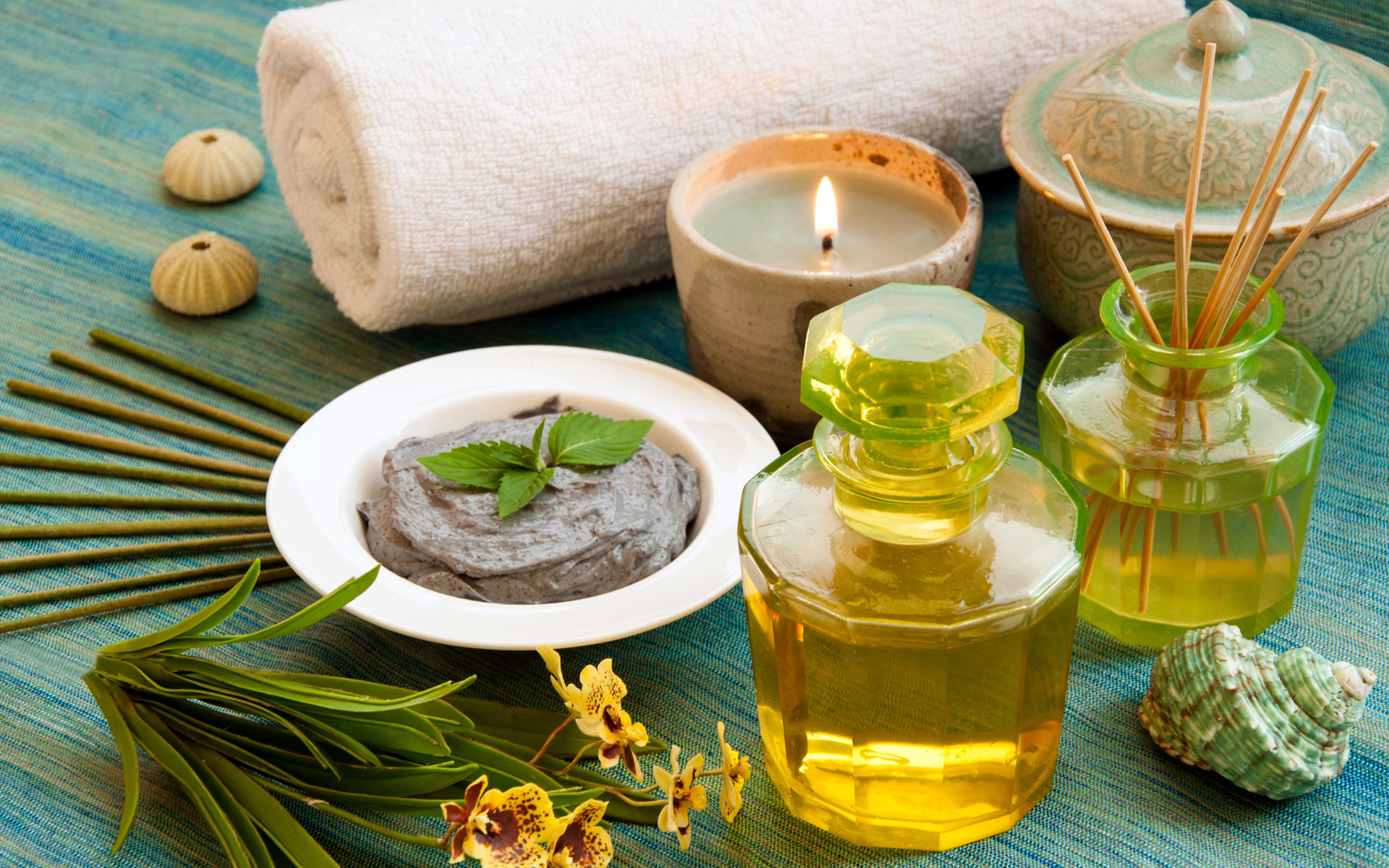 Aromatherapy is the science (and art), of using oils extracted from aromatic plants to enhance health, well-being and beauty. By using essential oils therapeutically one can treat a wide range of problems from stress and insomnia, to acne, menstrual cramps, depression and fatigue. Essential oils (also known as essences) are obtained from the distillation of herbs, plants and flowers. They all have different therapeutic effects on the body. Aromatherapy has a long history of use in ancient Egypt, China, and India.
Aromatherapy is the science (and art), of using oils extracted from aromatic plants to enhance health, well-being and beauty. By using essential oils therapeutically one can treat a wide range of problems from stress and insomnia, to acne, menstrual cramps, depression and fatigue. Essential oils (also known as essences) are obtained from the distillation of herbs, plants and flowers. They all have different therapeutic effects on the body. Aromatherapy has a long history of use in ancient Egypt, China, and India.
You may not even realize that you already use aromatherapy. When you burned that scented candle last week, you were practicing aromatherapy. When you walk through a fragrant garden, you are doing it again. Almost all of the bath and body care products we use contain some form of essential oils – the basis of aromatherapy.
The Power of Scent
People often don’t realize how strongly they are affected by scents. The smell of home made bread or of the ocean can bring back memories from years before; of happy time or bad times too. This is because the olfactory sense, the sense of smell, is interpreted by the part of the brain that is concerned with our emotions. Scents have a powerful effect on our moods. Adding different essential oils to your massage oil or bath oil can enhance the relaxing or invigorating effect of the massage or bath.
Some History: In 400 B.C. Hippocrates wrote, “The way to health is to have an aromatic bath and scented massage every day,” There are numerous references throughout history to the use of aromatic oils. The term aromatherapy was coined by a French chemist named Rene Gattefosse, in the 1920s. Several years earlier he had noticed the therapeutic effects of essential oils after burning his hand badly while working in his laboratory and accidentally dunking his hand into lavender oil. His hand healed very quickly and left no scars (so history tells us).
Some Research
 Research in the 1990s testifies to the strength of this link. Dr. Gary Schwartz, professor of psychology and psychiatry of Yale University, has found that certain odors can lower blood pressure. The scent of spiced apples was shown to be particularly effective — it lowered the blood pressure of healthy volunteers by an average of three to five points. Other scientific research has shown that pleasant smells such as peach and plum can reduce pain, and that essential oils can change peoples moods: jasmine, ilang-ilang and peppermint can life depression, geranium and bergamot relieve anxiety; and rose and carnation restore energy.
Research in the 1990s testifies to the strength of this link. Dr. Gary Schwartz, professor of psychology and psychiatry of Yale University, has found that certain odors can lower blood pressure. The scent of spiced apples was shown to be particularly effective — it lowered the blood pressure of healthy volunteers by an average of three to five points. Other scientific research has shown that pleasant smells such as peach and plum can reduce pain, and that essential oils can change peoples moods: jasmine, ilang-ilang and peppermint can life depression, geranium and bergamot relieve anxiety; and rose and carnation restore energy.
![]() Essential oils are a complex mixture of chemicals with many different properties. As well as affecting mood, some are antibacterial, antiseptic or anti-inflammatory. The chart on the next page lists some of the most common oils with the properties ascribed to them. The diversity of claims made for essential oils sometimes several claims for one oil, can cause confusion. A single oil may be described as both calming and stimulating. This sounds like a contradiction, causing skeptics to dismiss the whole subject. However, someone suffering from nervous tensions might first be calmed by the scent, and then, with this new freedom from tension, reclaim his natural energy and feel refreshed and energized.
Essential oils are a complex mixture of chemicals with many different properties. As well as affecting mood, some are antibacterial, antiseptic or anti-inflammatory. The chart on the next page lists some of the most common oils with the properties ascribed to them. The diversity of claims made for essential oils sometimes several claims for one oil, can cause confusion. A single oil may be described as both calming and stimulating. This sounds like a contradiction, causing skeptics to dismiss the whole subject. However, someone suffering from nervous tensions might first be calmed by the scent, and then, with this new freedom from tension, reclaim his natural energy and feel refreshed and energized.
Buying Essential Oils
 The price of essential oils varies greatly; for a small quantity of lavender oil you might pay only a fraction of the cost of the same amount of rose oil. This reflect the facts that it takes about 400 pounds of rose petals to product just a liter of rose oil, whereas 400 pounds of lavender flowers yields about 6 liters of essential oil. Most health food stores sell essential oils. They should always be sold in brown glass bottles (sometimes cobalt blue) to keep the light out — which can alter them chemically. They are sold in small quantities as only 3 – 5 drops goes a long way.
The price of essential oils varies greatly; for a small quantity of lavender oil you might pay only a fraction of the cost of the same amount of rose oil. This reflect the facts that it takes about 400 pounds of rose petals to product just a liter of rose oil, whereas 400 pounds of lavender flowers yields about 6 liters of essential oil. Most health food stores sell essential oils. They should always be sold in brown glass bottles (sometimes cobalt blue) to keep the light out — which can alter them chemically. They are sold in small quantities as only 3 – 5 drops goes a long way.
Blending Oils or “Carrier Oils”
 Essential oils are extremely concentrated and must always be diluted, otherwise they can sting and even cause allergies. To use them during a massage, you need to dilute them in a carrier oil. The most commonly used carrier oils are almond, olive, soya, grape-seed, avocado, hazelnut, peach and wheat-germ oils. Many of these are very expensive. Wheat germ oil is rich in vitamin E and acts as an antioxidant but it is a bit thick and heavy, so add just a little to a light carrier oil to prevent your massage oil from turning rancid. To dilute an essential oil, mix one to three drops with a 5 ml teaspoon of carrier oil. (Most essential oils will have directions on their label). If you want to make up a larger quantity, add 15 to 30 drops to 2 fluid oz. (50 ml) or carrier oil. Use a more diluted mixture on sensitive skin and on the face.
Essential oils are extremely concentrated and must always be diluted, otherwise they can sting and even cause allergies. To use them during a massage, you need to dilute them in a carrier oil. The most commonly used carrier oils are almond, olive, soya, grape-seed, avocado, hazelnut, peach and wheat-germ oils. Many of these are very expensive. Wheat germ oil is rich in vitamin E and acts as an antioxidant but it is a bit thick and heavy, so add just a little to a light carrier oil to prevent your massage oil from turning rancid. To dilute an essential oil, mix one to three drops with a 5 ml teaspoon of carrier oil. (Most essential oils will have directions on their label). If you want to make up a larger quantity, add 15 to 30 drops to 2 fluid oz. (50 ml) or carrier oil. Use a more diluted mixture on sensitive skin and on the face.
 Essential oils are not very oily, but they are very volatile liquids that evaporate quickly after use. Store them and your blended massage oil in a cool dark place in air tight bottles. Now, you might be asking, do I have to go to all this trouble? Not really. Today there are some wonderful products on the market that are already mixed for you. I got a very nice -Tranquility Blend” at a chain vitamin shop online. For example: it has oils of lavender, patchouli, sage, orange, grapefruit, and cypress. It is in a base of jojoba oil, macadamia oil, vitamins E and A and some preservatives to keep it fresh longer. Other products may use hazelnut and cocobutter as their carrier oils. Read the labels to see what is in them and make sure you can sample any body lotions before you buy them. Many shops in the malls now do have sample size lotions and essential oils. There are also some wonderful bath oils available also for whatever mood you want your bath to create. Just make sure to buy products that are in dark blue or brown bottles since the essential oils will change when exposed to light.
Essential oils are not very oily, but they are very volatile liquids that evaporate quickly after use. Store them and your blended massage oil in a cool dark place in air tight bottles. Now, you might be asking, do I have to go to all this trouble? Not really. Today there are some wonderful products on the market that are already mixed for you. I got a very nice -Tranquility Blend” at a chain vitamin shop online. For example: it has oils of lavender, patchouli, sage, orange, grapefruit, and cypress. It is in a base of jojoba oil, macadamia oil, vitamins E and A and some preservatives to keep it fresh longer. Other products may use hazelnut and cocobutter as their carrier oils. Read the labels to see what is in them and make sure you can sample any body lotions before you buy them. Many shops in the malls now do have sample size lotions and essential oils. There are also some wonderful bath oils available also for whatever mood you want your bath to create. Just make sure to buy products that are in dark blue or brown bottles since the essential oils will change when exposed to light.
Essential oil candles have become very popular, they work, but not as well as a lotion or oil-mix. If you are pregnant or nursing, check with your obstetrician before using any essential oil products. When I was trying to get pregnant my OB suggested I used the tranquility blend, but he practiced naturopathic medicine as well as traditional. SO, please check with your doctor or practitioner or midwife first. Here is a short oil chart, you can probably find very long ones in any health food store that sells essential oils. Most of the time they are free.
Important Guidelines for Using Essential Oils
Keep oils away from mucous membranes and eyes and never use them below your waist! If you have sensitive skin, test some oil on a small patch of skin — inside of your elbow is a good spot, before using it. Wait 24 hours, if irritation, redness, itching, or burning occurs, you should not use that oil!
When using aromatherapy on children age six to twelve and the elderly, cut all doses in half. If you have any questions at all, ask your health care provider if she or he thinks aromatherpy is safe for an elderly or ill person. Most practitioners do NOT advise using essential oils on infants. Do not use essential oils if you have high blood pressure or are on medication for high blood pressure. When in doubt, ask your health care provider!
And of course never take essential oils internally.
Choosing Essential Oils
![]() All essential oils add a feeling of luxury to a massage, so chose any that appeal to you. These are some of the most common essential oils and the properties ascribed to them. Feel free to blend oils and see what you get. Don’t blend more than two or three. If you are using a very expensive oil like rose, don’t blend it with anything except for the carrier oil.
All essential oils add a feeling of luxury to a massage, so chose any that appeal to you. These are some of the most common essential oils and the properties ascribed to them. Feel free to blend oils and see what you get. Don’t blend more than two or three. If you are using a very expensive oil like rose, don’t blend it with anything except for the carrier oil.
![]()
Bergamot: Antiseptic, astringent, antidepressant, uplifting and refreshing Helps depression, sore throat, digestive problems. Good for acne and oily hair. Do NOT use before sun exposure, it tends to make the skin sun-sensitive.
Chamomile: Calming, refreshing Helps: muscle aches, menstrual cramps, headache and digestive problems. Good for sensitive skin. Used in hair products to lighten blonde hair.
Cardamom: Antiseptic, helps digestive problems and gas, used for nausea and headache.
Eucalyptus: Antiseptic and stimulating. Used for treating coughs, colds and aches.
Frankincense: Calming, helps relaxation, said to fight wrinkles.
Geranium: Astringent, good for depression, tones the skin and used as an insect repellent hundreds of years ago.
Ilang-Ilang: Antiseptic, aphrodisiac. Good for dry skin and for blending other oils.
Jasmine: Antiseptic, aphrodisiac, said to ‘speed up labor’. Used for years for postpartum depression. (Never used without consulting your physician if you postnatal.)
Lavender: Antiseptic, antidepressant, relaxing and calming. Helps insomnia, menstrual cramps and most people will agree that is have a relaxing quality about it.
Marjoram: Sedative, warming, comforting.
Melissa: Refreshing and uplifting. Helps headaches and menstrual cramps.
Neroli: Calming, good for anxiety and insomnia.
Orange Oil: Good for blending, for an relaxing and calming massage. It is often mixed with lavendar or grapefruit oil.
Rose: Very expensive. Antiseptic, antidepressant. A little goes a long way.
Rosemary: Antiseptic, refreshing and stimulating. Used for headaches, migraines, the common cold and muscle aches. The stimulating properties are said to help ‘clear thinking’. Good for the memory.
Sandalwood: Antiseptic, calming, aphrodisiac. Useful for dry skin and used on acne.
Tea Tree Oil: Antiseptic, fungicide, treat minor cuts, good for minor acne.
![]() To Massage Techniques – Self-Massage
To Massage Techniques – Self-Massage
![]() The Mind-Body Approach to Illness
The Mind-Body Approach to Illness
![]() The Mind Body Approach to Health
The Mind Body Approach to Health
![]() Stress and Stress Management & Stress Skills
Stress and Stress Management & Stress Skills
